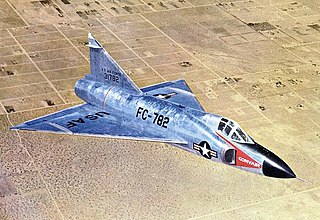
The Convair F-102 Delta Dagger is an interceptor aircraft designed and produced by the American aircraft manufacturer Convair. A member of the Century Series, the F-102 was the first operational supersonic interceptor and delta-wing fighter operated by the United States Air Force (USAF).

The Curtiss-Wright Model 21 was an American fighter-interceptor developed by the St. Louis Airplane Division of Curtiss-Wright Corporation during the 1930s.

The Vultee V-11 and V-12 were American stressed-skin monocoque monoplane attack aircraft of the 1930s. Developed from the Vultee V-1 single-engined airliner, the V-11 and V-12 were purchased by several nations for their armed forces, including China, who used them in combat against Japanese forces in the Second Sino-Japanese War. The United States Army Air Corps purchased seven V-11s as the YA-19 in the years before World War II, testing them to gather data to compare against twin engine light attack aircraft.
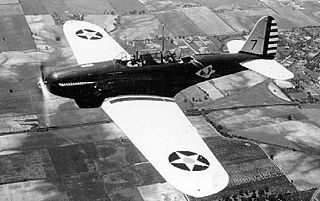
The Consolidated P-30 (PB-2) was a 1930s United States two-seat fighter aircraft. An attack version called the A-11 was also built, along with 2 Y1P-25 prototypes and YP-27, Y1P-28, and XP-33 proposals. The P-30 is significant for being the first fighter in United States Army Air Corps service to have retractable landing gear, an enclosed and heated cockpit for the pilot, and an exhaust-driven turbo-supercharger for altitude operation.

The Wittemann-Lewis NBL-1 "Barling Bomber" was an experimental long-range, heavy bomber built for the United States Army Air Service in the early 1920s. Although unsuccessful, it was an early attempt at creating a strategic bomber.
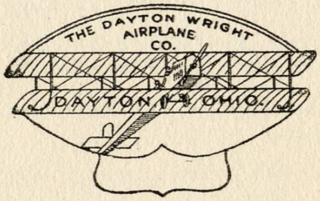
The Dayton-Wright Company was formed in 1917, on the declaration of war between the United States and Germany, by a group of Ohio investors that included Charles F. Kettering and Edward A. Deeds of Dayton Engineering Laboratories Company (DELCO). Orville Wright lent his name and served as a consultant, but other than that, the location of one of its three factories in the original Wright Company factory buildings in Dayton, Ohio was the only connection to the Wright brothers. In addition to plant 3, Dayton-Wright operated factories in Moraine and Miamisburg, Ohio. During the course of the war, Dayton-Wright produced about 3,000 DH-4s, as well as 400 Standard SJ-1 trainers. The company was hurt by the reputation of the DH-4s it produced as "flaming coffins" or "flying coffins", although they were not in reality more subject to catching fire than other aircraft, and by scandals it faced.

The Consolidated Model 17 Fleetster was a 1920s American light transport monoplane aircraft built by the Consolidated Aircraft Corporation. There was several closely related types the Model 17, Model 18, Model 20; then the C-11, C-22, and XBY military versions.

The Vultee V-1 is a 1930s American single-engined airliner built by the Airplane Development Corporation, designed by Gerard Vultee and financed by automobile manufacturer Errett Cord.

The Dayton-Wright OW.1 Aerial Coupe was an American four-seat touring aircraft built by the Dayton-Wright Company of Dayton, Ohio. Because it was the last aircraft designed by Orville Wright, the design was given the designation OW.1. The aircraft was based on a heavily modified De Havilland DH.4. Although only one was produced, the Dayton-Wright OW.1 marks the first working example of a civilian single-engine four passenger light cabin aircraft in the US. The interior was designed for greater comfort compared to contemporaries, and was meant to be more like an automobile interior. It had a side-opening door with two rows of two seats, and a greater focus on luxury.

The Dayton-Wright T-4 Messenger was a light, single-seat reconnaissance aircraft built in the United States by the Dayton-Wright Company in 1918 in the hope of gaining a production contract from the United States Army. It was a small conventional single-bay biplane with a neatly streamlined fuselage and staggered, equal-span wings. The undercarriage was of fixed tailskid type and the pilot sat in an open cockpit. Although diminutive, the design in fact started life as a scaled-up version of the Dayton-Wright Bug and shared a family resemblance to the de Havilland DH.4 that Dayton-Wright was building under licence during World War I. When the US Army was not interested in the aircraft, plans were made to sell it on the civil market, but these came to nothing and the prototype was the only example ever built.

The Dayton-Wright RB-1 , also known simply as the Dayton-Wright Racer was a high wing single-engine monoplane racing aircraft developed in the United States to participate in the 1920 Gordon Bennett Cup air race.
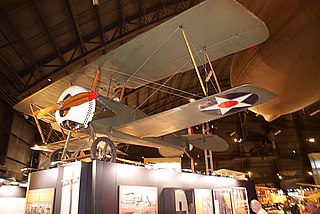
The Thomas-Morse S-4 Scout is an American biplane advanced trainer, operated by the United States Army and the United States Navy. Dubbed the "Tommy" by pilots who flew it, the aircraft became the favorite single-seat training airplane produced in the U.S. during World War I. It had a long and varied career beginning with the S-4B, which first appeared in the summer of 1917.

The Sikorsky S-36 was an eight-seat amphibian sesquiplane designed and built by the Sikorsky Manufacturing Company in the late 1920s. The aircraft was ordered by Pan American Airways, the start of a long association with Sikorsky flying boats.

The Verville-Sperry R-3 was a cantilever wing racing monoplane with a streamlined fuselage and the second aircraft with fully retractable landing gear, the first being the Dayton-Wright RB-1. In 1961, the R-3 racer was identified as one of the "Twelve Most Significant Aircraft of all Time" by Popular Mechanics magazine. In 1924, an R-3 won the Pulitzer Trophy in Dayton, OH.

The Thomas-Morse R-5 also known as the TM-22 was an American single-engined parasol monoplane racing aircraft of the 1920s. Two were built for the United States Army Air Service in 1922, but after competing in the 1922 Pulitzer Trophy Race the type was abandoned.

The Thomas-Morse MB-4 was a prototype American mailplane of the 1920s. It was of unusual design, being a biplane with twin fuselages housing the crew of two and a central nacelle which carried the aircraft's twin engines in a push-pull configuration.
The Thomas Morse MB-9 was an experimental American fighter aircraft of the 1920s. It was a single-engined, single-seat parasol winged monoplane, but was unsuccessful, being quickly abandoned.

The Martin RB-57D Canberra is a specialized high-altitude strategic reconnaissance aircraft developed from the Martin B-57 Canberra tactical bomber, a license-built version of the English Electric Canberra. It was used by the United States Air Force during the 1950s prior to operational use of the Lockheed U-2.

The Stinson Model R was an American light aircraft built by the Stinson Aircraft Company in the early 1930s. It was a single-engine high-winged monoplane, developed from the Stinson Junior. 39 units were built.
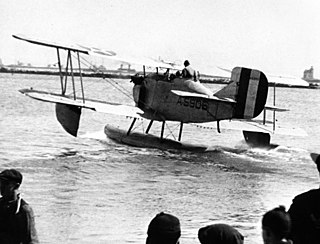
G Elias & Brother was an American manufacturer of cabinets and aircraft based in Buffalo, New York in the 1920s. A.G. Elias sat on the Manufacturers Aircraft Association's board of directors along with President Frank H. Russell, VP Glenn L. Martin, Charles L. Laurence, Chance M. Vought, S.S. Bradley, George P. Tidmarsh, and Donald Douglas. E.J Elias promoted the construction of a Buffalo municipal airport to aid the local fledgling airplane industry of five aviation companies constructing airplanes and airplane parts. From 1920 to 1925, Elias company's chief engineer, David Earle Dunlap (1896-1957), designed the Elias EM-2 Expeditionary planes. He designed the NBS-3 bomber fuselage and the Elias M-1 Mail plane. Dunlap's Elias TA-1 design was the first United States Army Air Corps Trainer to have a radial engine. After tests a McCook Field, the Army Air Corps selected other manufacturers over the Elias bomber and trainer. The company designed the Elias EM-1 to meet requirements for a multirole amphibian marine expeditionary aircraft. Elias delivered six production Elias EM-2 aircraft with Liberty engines to the United States Navy in 1922.



















